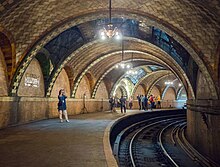Subterranean New York City relates to the area beneath the surface level of New York City; the natural features, man-made structures, spaces, objects, and cultural creation and experience. Like other subterranea, the underground world of New York City has been the basis of TV series, documentaries, artwork, and books.



History
editStreams, springs and swamps were once a more prominent feature in New York City (NYC). Manhattan for instance has numerous tidally-affected streams that run beneath street level, their existence sub-surface due to development. An example is the Minetta Brook which exists beneath Minetta Lane in Greenwich Village. Water seepage is a problem in the underground spaces of NYC and pumping is necessary to divert it elsewhere.[1][2] The predominant bedrock underneath NYC is Manhattan Schist.[3]
Some subterranean spaces of New York city are inhabited by so-called Mole people.[4] They were the subject of a 2008 documentary called Voices in the Tunnels.
Municipal services continued to develop and NYC has an extensive sewerage system, steam lines, water channels and other utility systems; and a vast and sometimes deep network of underground space and passages. The workers who excavate this realm are called 'sandhogs' and their origin as an organized group goes back to 8 May 1872.[5] Relics of the past exist beneath the surface, and engineering services have claimed to unearth the likes of old trolley tracks that exist beneath the tarmac and the pneumatic systems of the United States Treasury Department and United States Post Office; the latter of which went into service in 1872 for mail transport.[6][7]
Pop culture and art
editThe underground world of New York City has been the subject of TV series, films, paintings and books. In the popular fictional TV series Teenage Mutant Ninja Turtles, the sewer system was the turtles' home and their means of navigating swiftly underneath the sprawling city above. Books involving the topic include The Underland Chronicles, Downsiders, Visages Immobiles and the Marvel comic series Morlocks.
As an artistic subject, the NYC Subway was painted by Mark Rothko in his 'subway series', with expression of the architectural elements and space, in contrast to the scenes depicted in the book Manhattan Transfer by Don Passo which detail the hustle and bustle of people.[8] Graffiti artists have used NYC's sub-terranea and associated objects as the canvas itself, painting and writing on subways and trains. NYC in the 1970s and 1980s is regularly considered the height of subway art.[9]
The abandoned Cobble Hill railroad tunnel was the subject of a segment on an episode of the U.S History Channel's Cities of the Underworld.
In the late 1990s, following on from an article about the subject, the National Geographic created a feature on their website where users could digitally explore elements of subterranean NYC.[10]
Flora and fauna
editPublic transport
editRail
editRoad
editMunicipal services
editSee also
editReferences
edit- ^ Solis 2020, p. 11.
- ^ Langeweische, William (2013). "What Lies Beneath". Vanity Fair.
- ^ Solis 2020, p. X.
- ^ Tierney, John (1990-06-13). "In Tunnel, 'Mole People' Fight to Save Home". The New York Times.
- ^ Fifield, Adam (2003-01-12). "The Underground Men". The New York Times.
- ^ Scandino, Albert (1986-10-27). "Subterranean Engineers". The New York times.
- ^ Ovenden 2020, p. 56.
- ^ Linder 2015, p. 186.
- ^ Knoll, Corinna (2022-06-03). "For 2 Graffiti Artists, New York's Subway Was Irresistible and Deadly". The New York Times.
- ^ Weir, Richard (1999-01-24). "NEIGHBORHOOD REPORT: NEW YORK ON LINE; About Those Alligators in the Sewers . . ". The New York Times.
Sources
edit- Lindner, Christopher (2015). Imagining New York City - Literature, Urbanism, and the Visual Arts, 1890-1940. Oxford University Press. ISBN 9780195375145.
- Solis, Julia (2020). New York Underground The Anatomy of a City. Taylor & Francis. ISBN 9781000143614.
- Ovenden, Mark (2020). Underground Cities Mapping the Tunnels, Transits and Networks Underneath Our Feet. Frances Lincoln. ISBN 9781781318942.